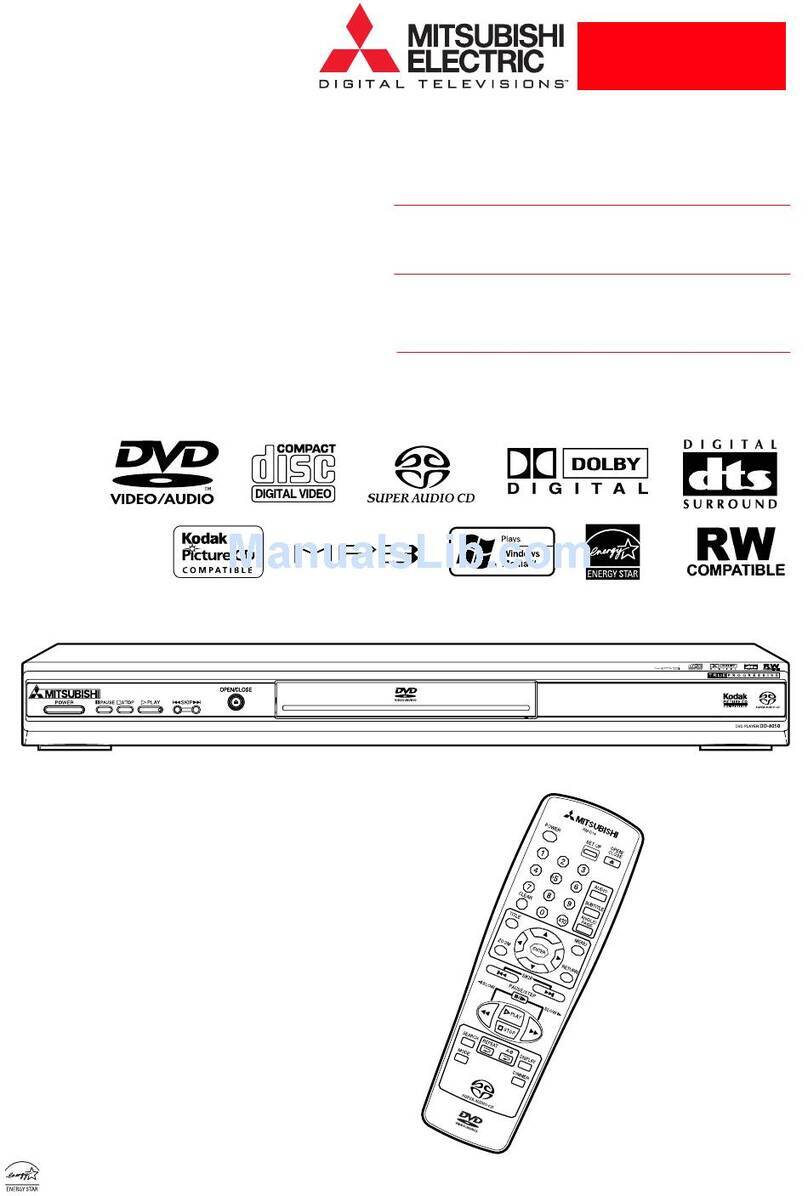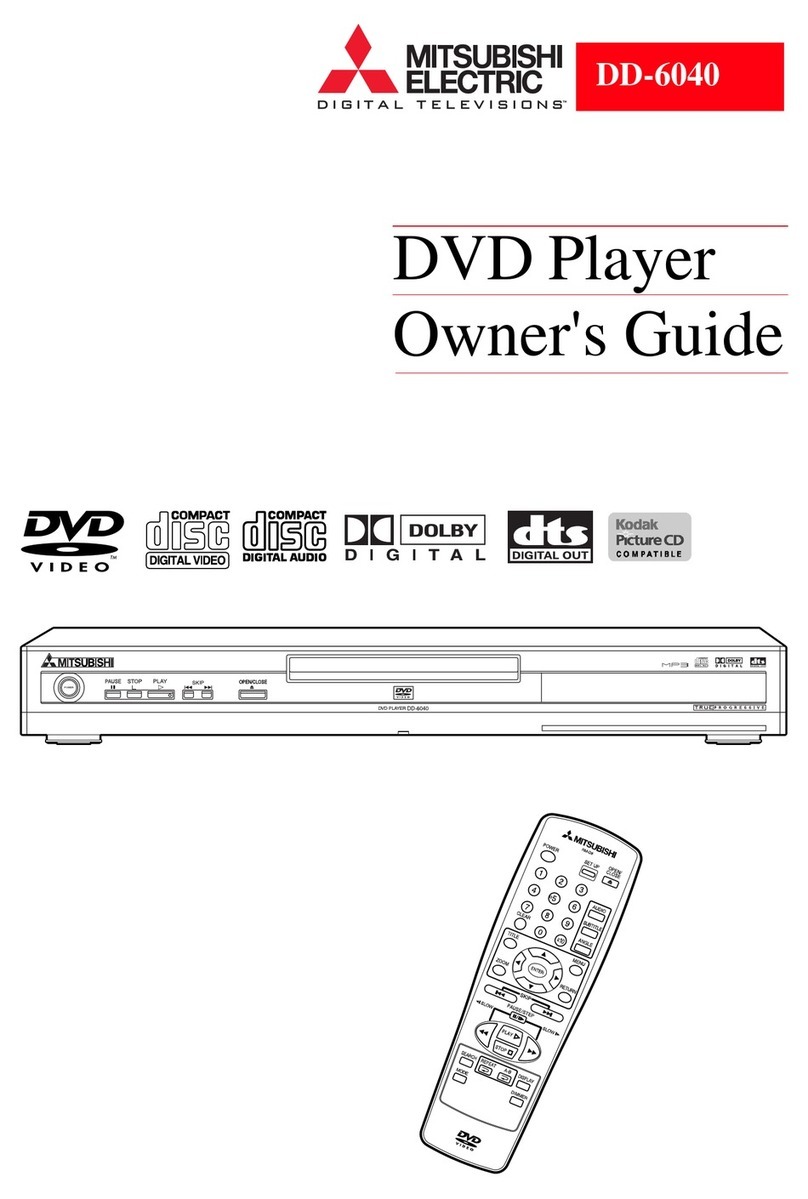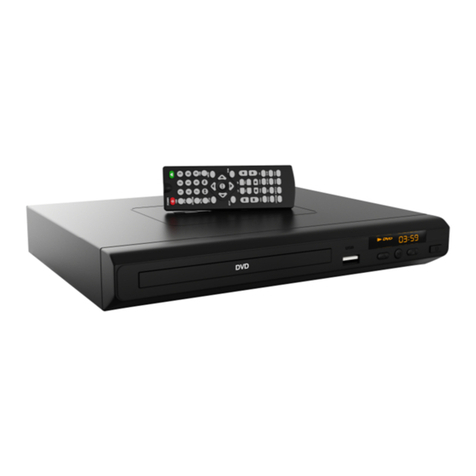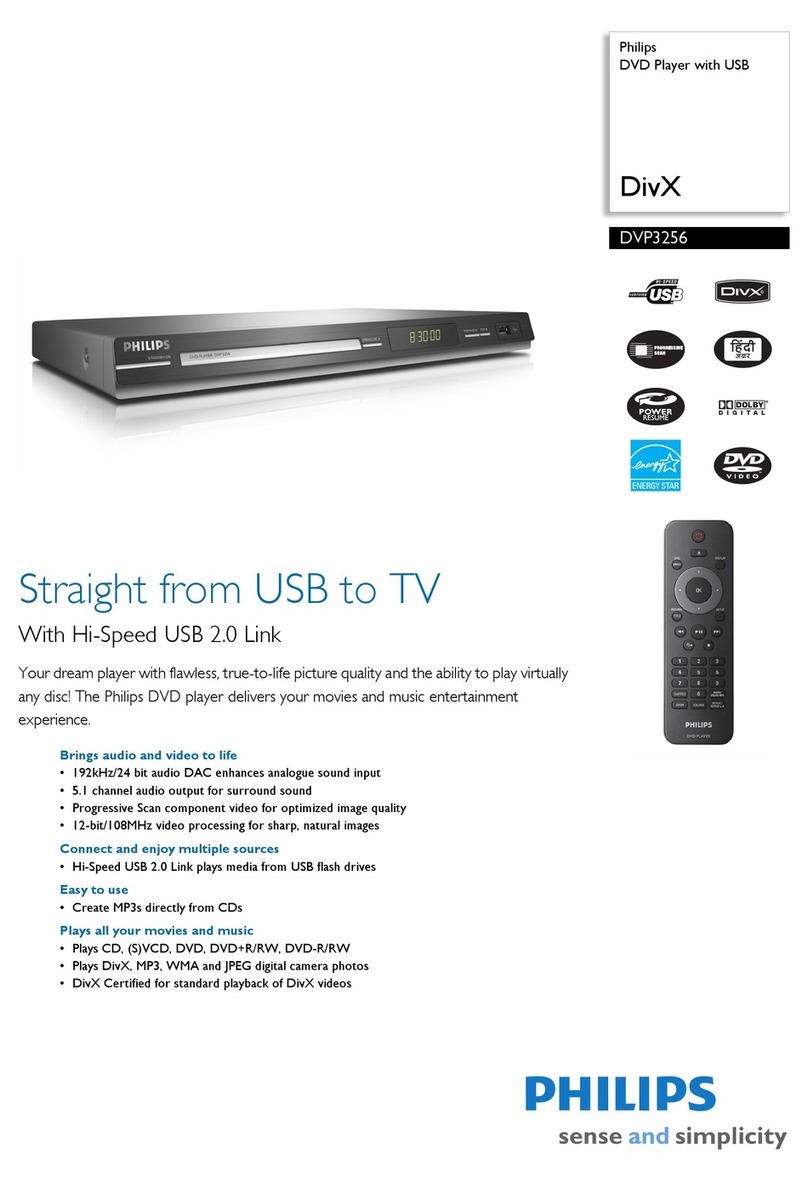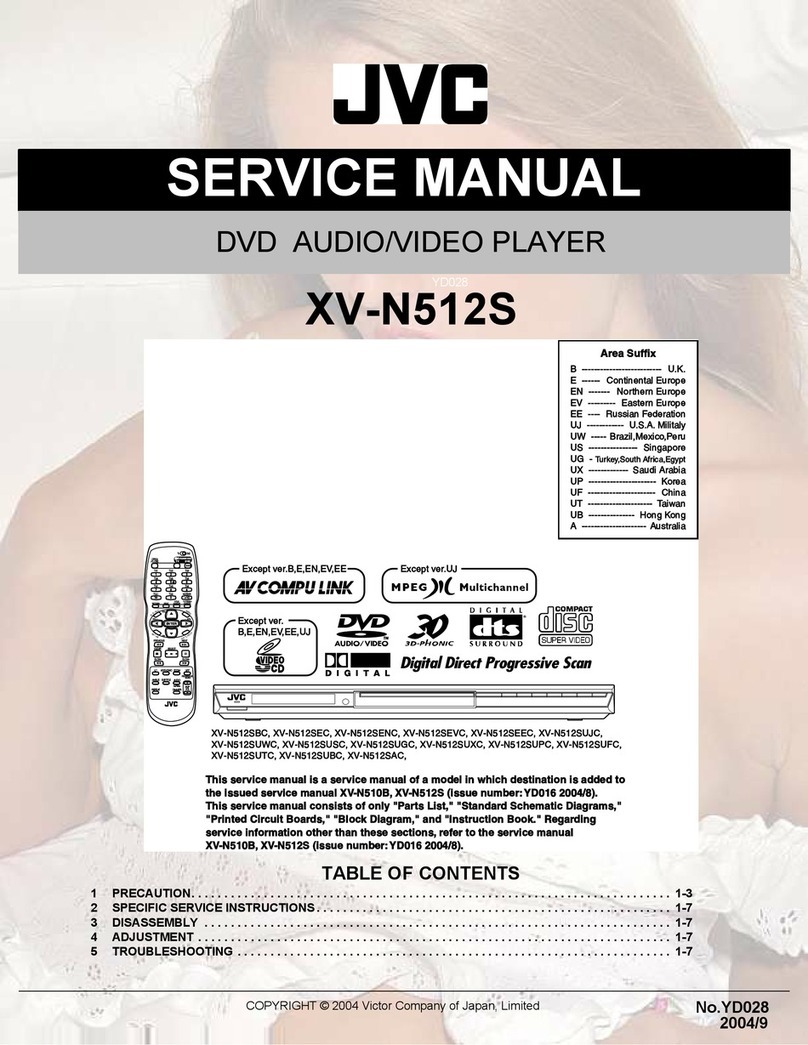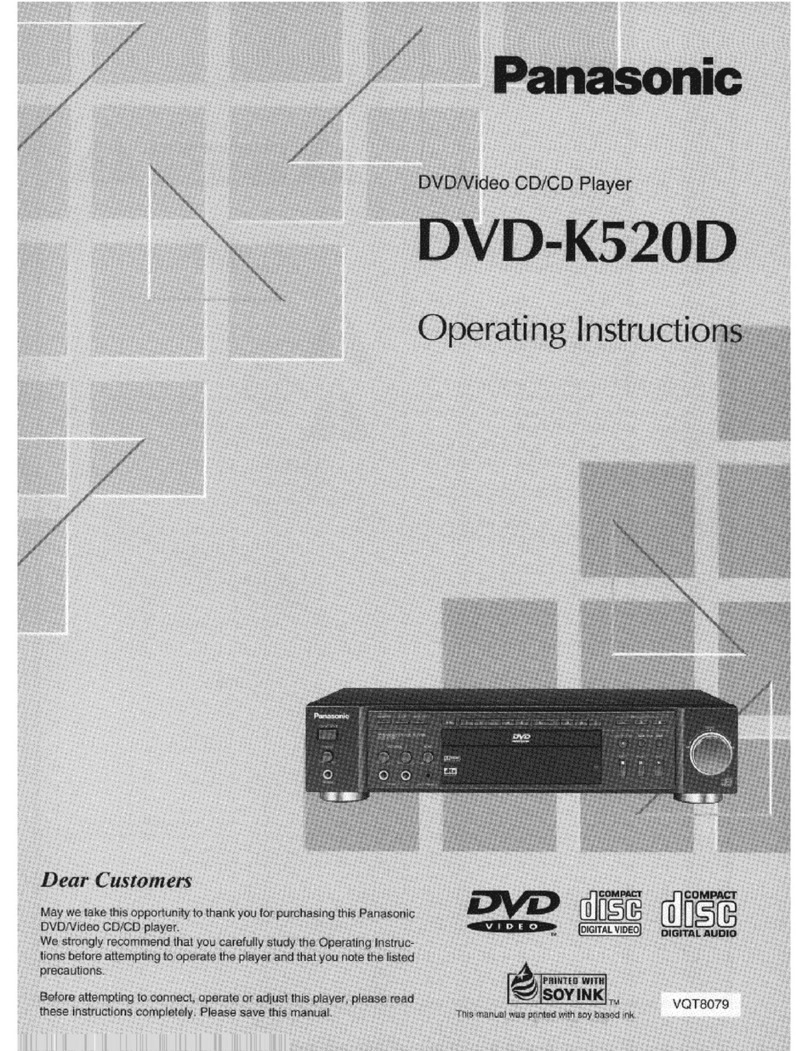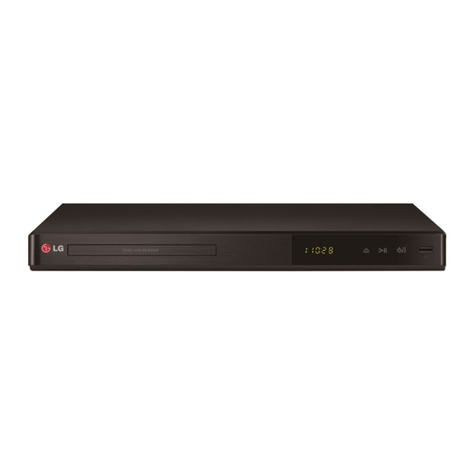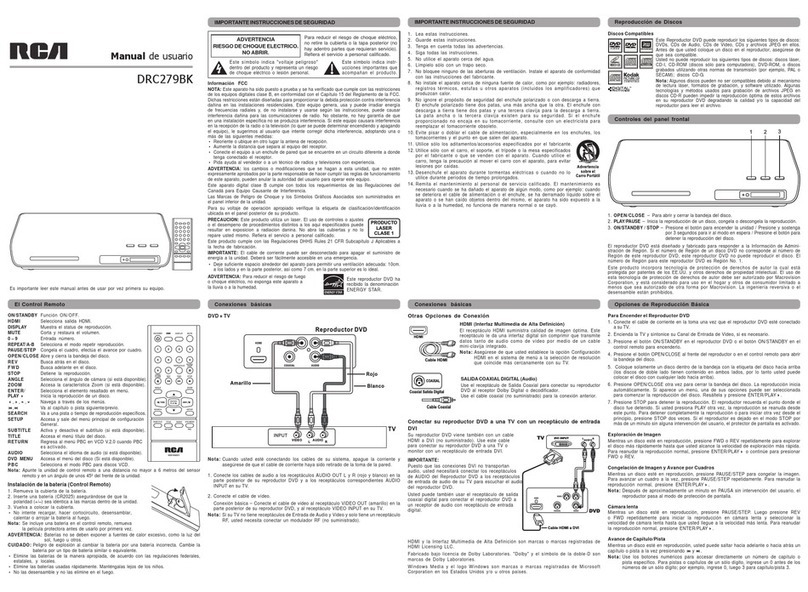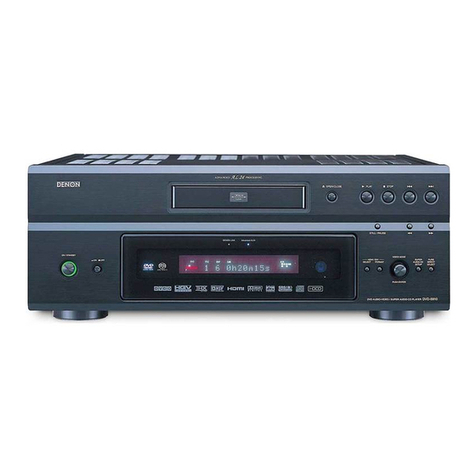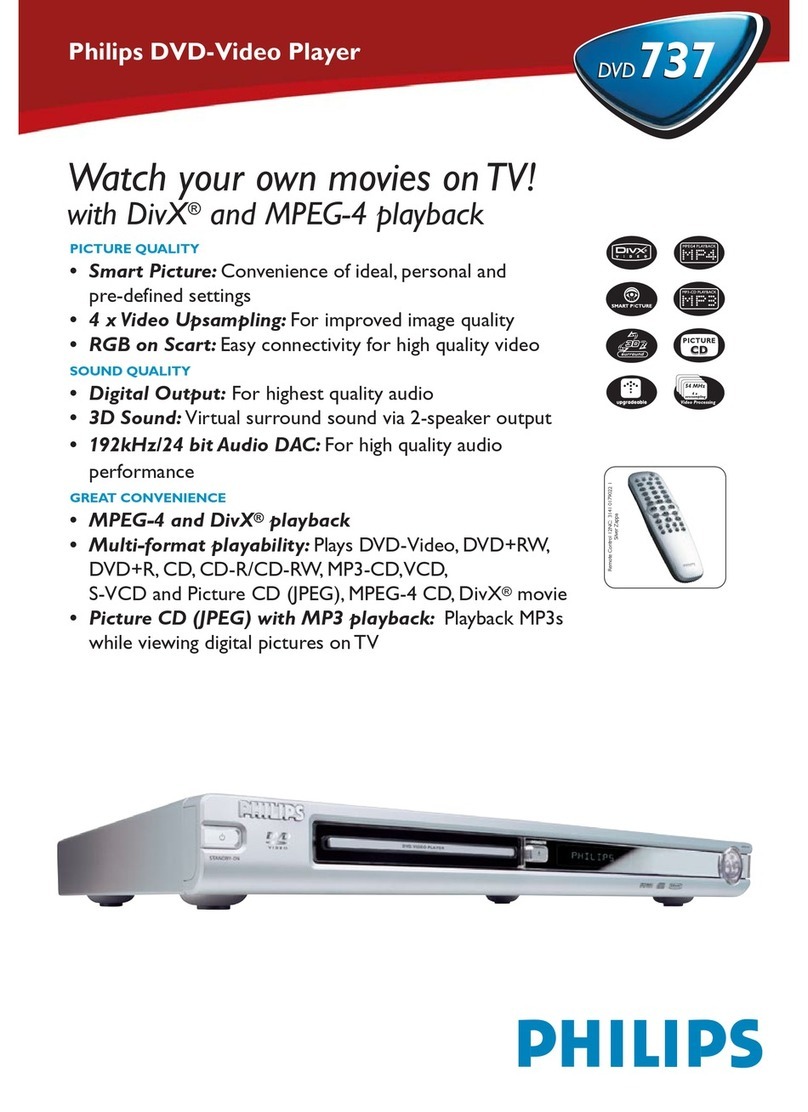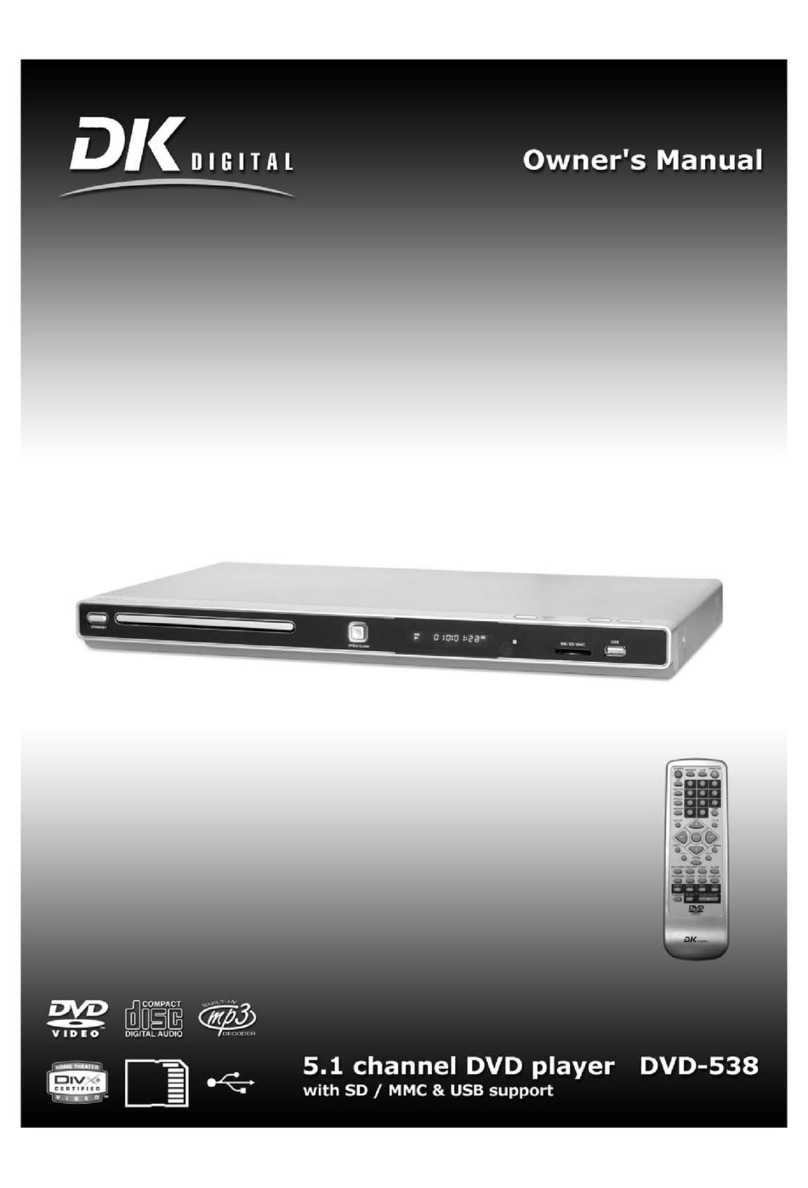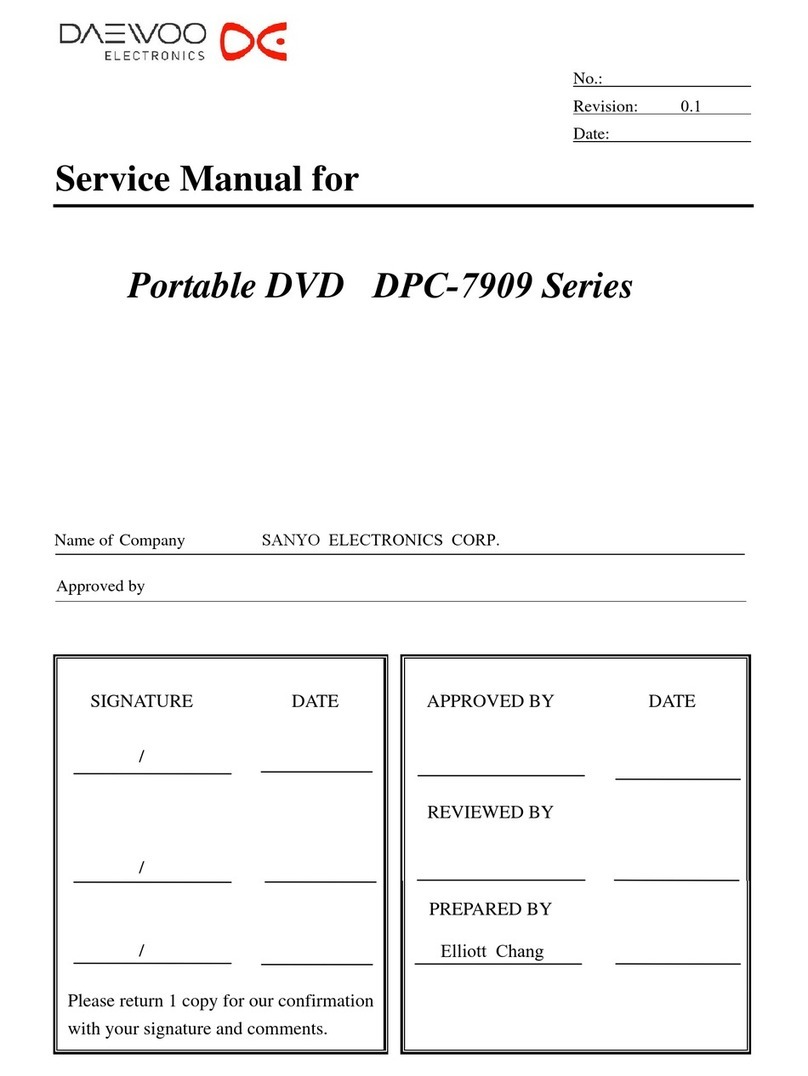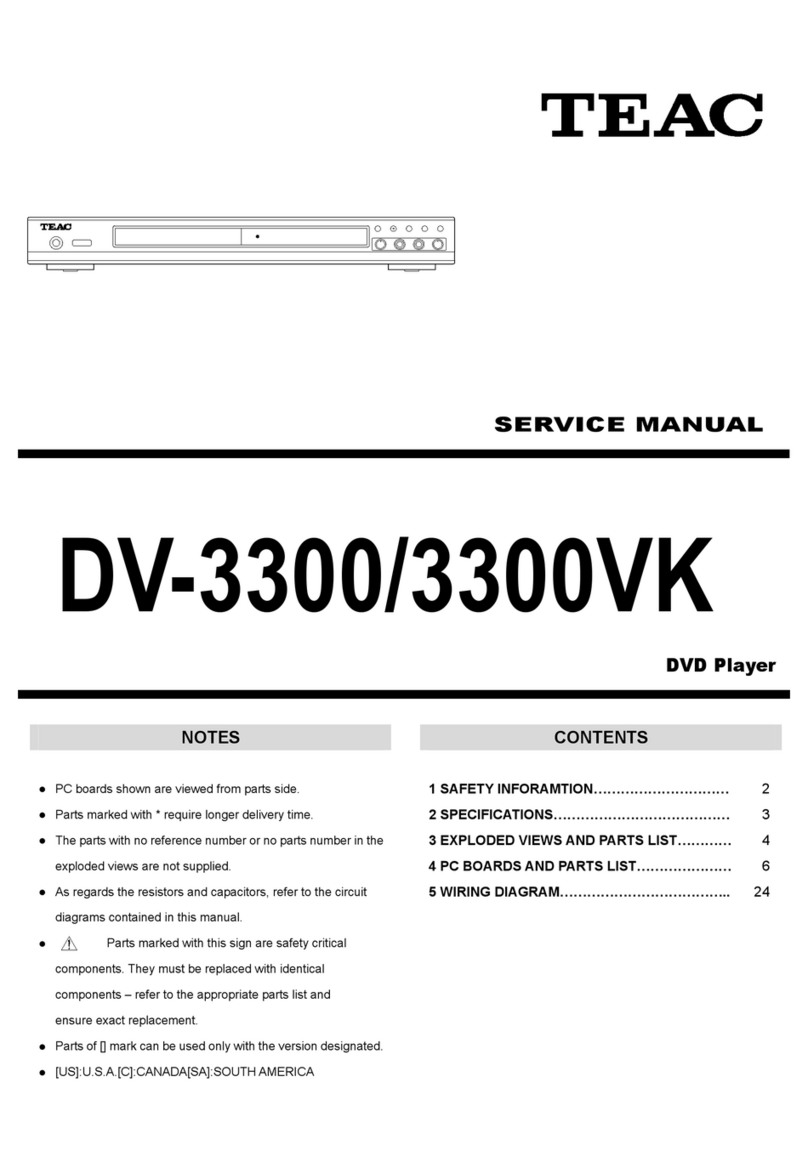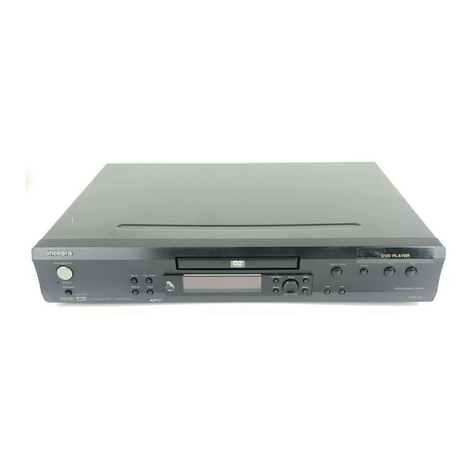Mitsubishi DD-6040 User manual

DVD PLAYER
2003
MODEL
DD-6040
Manual
Service
MITSUBISHI ELECTRIC
TABLE OF CONTENTS
SPECIFICATIONS .. . . . . . . . . . . . . . . . . . . . . . . . . . . . . . . . . . . . . . . . . . . . . . . . . . . . . . . . . . . . . . . . . . . . . .1-1-1
LASER BEAM SAFETY PRECAUTIONS. . . . . . . . . . . . . . . . . . . . . . . . . . . . . . . . . . . . . . . . . . . . . . . . . . . . . .1-2-1
IMPORTANT SAFETY PRECAUTIONS . . . . . . . . . . . . . . . . . . . . . . . . . . . . . . . . . . . . . . . . . . . . . . . . . . . . . .1-3-1
STANDARD NOTES FOR SERVICING. . . . . . . . . . . . . . . . . . . . . . . . . . . . . . . . . . . . . . . . . . . . . . . . . . . . . . .1-4-1
OPERATING CONTROLS AND FUNCTIONS. . . . . . . . . . . . . . . . . . . . . . . . . . . . . . . . . . . . . . . . . . . . . . . . . .1-5-1
CABINET DISASSEMBLY INSTRUCTIONS . . . . . . . . . . . . . . . . . . . . . . . . . . . . . . . . . . . . . . . . . . . . . . . . . . .1-6-1
BLOCK DIAGRAMS. . . . . . . . . . . . . . . . . . . . . . . . . . . . . . . . . . . . . . . . . . . . . . . . . . . . . . . . . . . . . . . . . . . . . .1-7-1
SCHEMATIC DIAGRAMS / CBA'S AND TEST POINTS . . . . . . . . . . . . . . . . . . . . . . . . . . . . . . . . . . . . . . . . . .1-8-1
WAVEFORMS . . . . . . . . . . . . . . . . . . . . . . . . . . . . . . . . . . . . . . . . . . . . . . . . . . . . . . . . . . . . . . . . . . . . . . . . . .1-9-1
WIRING DIAGRAM . . . . . . . . . . . . . . . . . . . . . . . . . . . . . . . . . . . . . . . . . . . . . . . . . . . . . . . . . . . . . . . . . . . . .1-10-1
FIRMWARE RENEWAL MODE . . . . . . . . . . . . . . . . . . . . . . . . . . . . . . . . . . . . . . . . . . . . . . . . . . . . . . . . . . . .1-11-1
SYSTEM CONTROL TIMING CHARTS. . . . . . . . . . . . . . . . . . . . . . . . . . . . . . . . . . . . . . . . . . . . . . . . . . . . . .1-12-1
IC PIN FUNCTION DESCRIPTIONS . . . . . . . . . . . . . . . . . . . . . . . . . . . . . . . . . . . . . . . . . . . . . . . . . . . . . . . .1-13-1
LEAD IDENTIFICATIO. . . . . . . . . . . . . . . . . . . . . . . . . . . . . . . . . . . . . . . . . . . . . . . . . . . . . . . . . . . . . . . . . . .1-14-1
EXPLODED VIEWS . . . . . . . . . . . . . . . . . . . . . . . . . . . . . . . . . . . . . . . . . . . . . . . . . . . . . . . . . . . . . . . . . . . . .1-15-1
PARTS LIST . . . . . . . . . . . . . . . . .. . . . . . . . . . . . . . . . . . . . . . . . . . . . . . . . . . . . . . . . . . . . . . . . .. . . . . . . .1-15-2
.
I
MITSUBISHI DIGITAL ELECTRONICS AMERICA, INC.
9351 Jeronimo Road, Irvine, CA 92618-1904
Copyright © 2003Mitsubishi Digital Electronics America, Inc.
AllRightsReserved

Manufactured under license from Dolby Laboratories. "Dolby"
and the double-D symbol are trademarks of Dolby Laboratories.

1-1-1 E5731SP
SPECIFICATIONS
NOTES:
1. All Items are measured without pre-emphasis unless otherwise specified.
2. Power supply : AC120 V 60 Hz
3. Load imp. : 100 K ohm
4. Room ambient : 5 °C ~ 40 °C
ITEM CONDITIONS UNIT NOMINAL LIMIT
1. Video Output 75 ohm load Vpp 1.0 ± 0.1
2. Optical Digital Out dBm -18
3. Audio (PCM)
3-1. Output Level 1kHz 0dB Vrms 2.0
3-2. S/N dB 120
3-3. Freq. Response
DVD fs=48kHz 20~22kHz dB ± 0.5
CD fs=44.1kHz 20~20 kHz dB ± 0.5
3-4. THD+N
DVD 1 kHz 0dB % 0.0025
CD 1 kHz 0dB % 0.003

1-2-1 DVD_LASER
Drive Mecha Assembly
Laser Beam Radiation
Laser Pickup
Turntable
LASER RADIATION
WHEN OPEN. DO NOT
STARE INTO BEAM.
CAUTION
LASER BEAM SAFETY PRECAUTIONS
This DVD player uses a pickup that emits a laser beam.
The laser beam is emitted from the location shown in the figure. When checking the laser diode, be sure to keep
your eyes at least 30cm away from the pickup lens when the diode is turned on. Do not look directly at the laser
beam.
Caution: Use of controls and adjustments, or doing procedures other than those specified herein, may result in
hazardous radiation exposure.
Do not look directly at the laser beam coming
from the pickup or allow it to strike against
your skin.
Location: Inside Top of DVD mechanism.

1-3-1 DVD_SFN1
IMPORTANT SAFETY PRECAUTIONS
Product Safety Notice
Some electrical and mechanical parts have special
safety-related characteristics which are often not evi-
dent from visual inspection, nor can the protection they
give necessarily be obtained by replacing them with
components rated for higher voltage, wattage, etc.
Parts that have special safety characteristics are iden-
tified by a #on schematics and in parts lists. Use of a
substitute replacement that does not have the same
safety characteristics as the recommended replace-
ment part might create shock, fire, and/or other haz-
ards. The Product’s Safety is under review
continuously and new instructions are issued when-
ever appropriate. Prior to shipment from the factory,
our products are carefully inspected to confirm with
the recognized product safety and electrical codes of
the countries in which they are to be sold. However, in
order to maintain such compliance, it is equally impor-
tant to implement the following precautions when a set
is being serviced.
Precautions during Servicing
A. Parts identified by the #symbol are critical for
safety. Replace only with part number specified.
B. In addition to safety, other parts and assemblies
are specified for conformance with regulations
applying to spurious radiation. These must also be
replaced only with specified replacements.
Examples: RF converters, RF cables, noise block-
ing capacitors, and noise blocking filters, etc.
C. Use specified internal wiring. Note especially:
1)Wires covered with PVC tubing
2)Double insulated wires
3)High voltage leads
D. Use specified insulating materials for hazardous
live parts. Note especially:
1)Insulation tape
2)PVC tubing
3)Spacers
4)Insulators for transistors
E. When replacing AC primary side components
(transformers, power cord, etc.), wrap ends of
wires securely about the terminals before solder-
ing.
F. Observe that the wires do not contact heat produc-
ing parts (heatsinks, oxide metal film resistors, fus-
ible resistors, etc.).
G. Check that replaced wires do not contact sharp
edges or pointed parts.
H. When a power cord has been replaced, check that
5 - 6 kg of force in any direction will not loosen it.
I. Also check areas surrounding repaired locations.
J. Be careful that foreign objects (screws, solder
droplets, etc.) do not remain inside the set.
K. Crimp type wire connector
The power transformer uses crimp type connectors
which connect the power cord and the primary side
of the transformer. When replacing the transformer,
follow these steps carefully and precisely to prevent
shock hazards.
Replacement procedure
1)Remove the old connector by cutting the wires at a
point close to the connector.
Important: Do not re-use a connector. (Discard it.)
2)Strip about 15 mm of the insulation from the ends
of the wires. If the wires are stranded, twist the
strands to avoid frayed conductors.
3)Align the lengths of the wires to be connected.
Insert the wires fully into the connector.
4)Use a crimping tool to crimp the metal sleeve at its
center. Be sure to crimp fully to the complete clo-
sure of the tool.
L. When connecting or disconnecting the internal
connectors, first, disconnect the AC plug from the
AC outlet.

1-3-2 DVD_SFN1
Chassis or Secondary Conductor
dd'
Primary Circuit Terminals
AC Voltmeter
(High Impedance)
Exposed Accessible Part
BEarth Ground
Power Cord Plug Prongs
Z
1.5k 0.15 F
Safety Check after Servicing
Examine the area surrounding the repaired location for
damage or deterioration. Observe that screws, parts,
and wires have been returned to their original posi-
tions. Afterwards, do the following tests and confirm
the specified values to verify compliance with safety
standards.
1. Clearance Distance
When replacing primary circuit components, confirm
specified clearance distance (d) and (d’) between sol-
dered terminals, and between terminals and surround-
ing metallic parts. (See Fig. 1)
Table 1 : Ratings for selected area
Note: This table is unofficial and for reference only.
Be sure to confirm the precise values.
2. Leakage Current Test
Confirm the specified (or lower) leakage current
between B (earth ground, power cord plug prongs)
and externally exposed accessible parts (RF termi-
nals, antenna terminals, video and audio input and
output terminals, microphone jacks, earphone jacks,
etc.) is lower than or equal to the specified value in the
table below.
Measuring Method (Power ON) :
Insert load Z between B (earth ground, power cord
plug prongs) and exposed accessible parts. Use an
AC voltmeter to measure across the terminals of load
Z. See Fig. 2 and the following table.
AC Line Voltage Clearance Distance (d) (d’)
120 V ≥3.2mm (0.126 inches)
Table 2: Leakage current ratings for selected areas
Note: This table is unofficial and for reference only. Be sure to confirm the precise values.
AC Line Voltage Load Z Leakage Current (i) Earth Ground (B) to:
120 V 0.15µF CAP. & 1.5kΩ RES.
Connected in parallel i≤0.5mA Peak Exposed accessible parts
Fig. 1
Fig. 2

1-4-1 DVD_NOTE
STANDARD NOTES FOR SERVICING
Circuit Board Indications
a. The output pin of the 3 pin Regulator ICs is indi-
cated as shown.
b. For other ICs, pin 1 and every fifth pin are indicated
as shown.
c. The 1st pin of every male connector is indicated as
shown.
Instructions for Connectors
1. When you connect or disconnect the FFC (Flexible
Foil Connector) cable, be sure to first disconnect
the AC cord.
2. FFC (Flexible Foil Connector) cable should be
inserted parallel into the connector, not at an angle.
How to Remove / Install Flat Pack-IC
1. Removal
With Hot-Air Flat Pack-IC Desoldering Machine:.
(1) Prepare the hot-air flat pack-IC desoldering
machine, then apply hot air to the Flat Pack-IC
(about 5 to 6 seconds). (Fig. S-1-1)
(2) Remove the flat pack-IC with tweezers while apply-
ing the hot air.
(3) Bottom of the flat pack-IC is fixed with glue to the
CBA; when removing entire flat pack-IC, first apply
soldering iron to center of the flat pack-IC and heat
up. Then remove (glue will be melted). (Fig. S-1-6)
(1) Release the flat pack-IC from the CBA using twee-
zers. (Fig. S-1-6)
Caution:
1. Do not supply hot air to the chip parts around the
flat pack-IC for over 6 seconds because damage to
the chip parts may occur. Put masking tape around
the flat pack-IC to protect other parts from damage.
(Fig. S-1-2)
2. The flat pack-IC on the CBA is affixed with glue, so
be careful not to break or damage the foil of each
pin or the solder lands under the IC when removing
it.
Top View
Out In
Bottom View
Input
5
10
Pin 1
Pin 1
FFC Cable
Connector
CBA
* Be careful to avoid a short circuit.
Fig. S-1-1
Hot-air
Flat Pack-IC
Desoldering
Machine
CBA
Flat Pack-IC
Tweezers
Masking
Tape
Fig. S-1-2

1-4-2 DVD_NOTE
With Soldering Iron:
(1)Using desoldering braid, remove the solder from all
pins of the flat pack-IC. When you use solder flux
which is applied to all pins of the flat pack-IC, you
can remove it easily. (Fig. S-1-3)
(2)Lift each lead of the flat pack-IC upward one by
one, using a sharp pin or wire to which solder will
not adhere (iron wire). When heating the pins, use
a fine tip soldering iron or a hot air desoldering
machine. (Fig. S-1-4)
(3)Bottom of the flat pack-IC is fixed with glue to the
CBA; when removing entire flat pack-IC, first apply
soldering iron to center of the flat pack-IC and heat
up. Then remove (glue will be melted). (Fig. S-1-6)
(4)Release the flat pack-IC from the CBA using twee-
zers. (Fig. S-1-6)
With Iron Wire:
(1)Using desoldering braid, remove the solder from all
pins of the flat pack-IC. When you use solder flux
which is applied to all pins of the flat pack-IC, you
can remove it easily. (Fig. S-1-3)
(2)Affix the wire to a workbench or solid mounting
point, as shown in Fig. S-1-5.
(3)While heating the pins using a fine tip soldering
iron or hot air blower, pull up the wire as the solder
melts so as to lift the IC leads from the CBA contact
pads as shown in Fig. S-1-5
(4) Bottom of the flat pack-IC is fixed with glue to the
CBA; when removing entire flat pack-IC, first apply
soldering iron to center of the flat pack-IC and heat
up. Then remove (glue will be melted). (Fig. S-1-6)
(5) Release the flat pack-IC from the CBA using twee-
zers. (Fig. S-1-6)
Note:
When using a soldering iron, care must be taken
to ensure that the flat pack-IC is not being held by
glue. When the flat pack-IC is removed from the
CBA, handle it gently because it may be damaged
if force is applied.
Flat Pack-IC Desoldering Braid
Soldering Iron
Fig. S-1-3
Fine Tip
Soldering Iron
Sharp
Pin
Fig. S-1-4
To Solid
Mounting Point
Soldering Iron
Iron Wire
or
Hot Air Blower
Fig. S-1-5
Fine Tip
Soldering Iron
CBA
Flat Pack-IC
Tweezers
Fig. S-1-6

1-4-3 DVD_NOTE
2. Installation
(1)Using desoldering braid, remove the solder from
the foil of each pin of the flat pack-IC on the CBA
so you can install a replacement flat pack-IC more
easily.
(2)The “I” mark on the flat pack-IC indicates pin 1.
(See Fig. S-1-7.) Be sure this mark matches the 1
on the PCB when positioning for installation. Then
presolder the four corners of the flat pack-IC. (See
Fig. S-1-8.)
(3)Solder all pins of the flat pack-IC. Be sure that none
of the pins have solder bridges.
Instructions for Handling
Semi-conductors
Electrostatic breakdown of the semi-conductors may
occur due to a potential difference caused by electro-
static charge during unpacking or repair work.
1. Ground for Human Body
Be sure to wear a grounding band (1MΩ) that is prop-
erly grounded to remove any static electricity that may
be charged on the body.
2. Ground for Workbench
(4) Be sure to place a conductive sheet or copper plate
with proper grounding (1MΩ) on the workbench or
other surface, where the semi-conductors are to be
placed. Because the static electricity charge on
clothing will not escape through the body ground-
ing band, be careful to avoid contacting semi-con-
ductors with your clothing.
Example :
Pin 1 of the Flat Pack-IC
is indicated by a " " mark. Fig. S-1-7
Presolder
CBA
Flat Pack-IC
Fig. S-1-8
CBA
< Incorrect >
CBA
Grounding Band
Conductive Sheet or
Copper Plate
1MΩ
1MΩ
< Correct >

1-5-1 E5731IB
4 5 6 7 8321
FRONT PANEL
REMOTE CONTROL
1
9
10
6
11
28
13
27
26
14
18
16
17
15
25
12 24
23
5
2
4
22
3
21
20
19
1. POWER Button
Press to turn the power on and off.
2. PAUSE Button (main unit)
Pauses the current disc operation.
PAUSE/STEP Button (remote control)
Pauses the current disc operation. View the still
picture frame by frame.
3. STOP Button
Stops operation of the disc.
4. PLAY Button
Starts playback of the disc contents.
5. SKIP Buttons
G: Plays back from the beginning of the next
chapter or track.
j:Plays back from the beginning of the current
chapter or track.
6. OPEN/CLOSE Button
Press to insert or remove discs from the tray.
7. Disc loading tray
8. Display, Remote Sensor Window
9. Numeric Buttons
10. CLEAR Button
Resets a setting.
11. TITLE Button
Displays the title menu.
12. Arrow Buttons
Use to scroll and cycle through disc and player men
us
and settings.
13. ENTER Button
Press to accept a setting.
14. ZOOM Button
Enlarges part of a DVD-reproduced image.
15. REV Button
Fast reverse playback to a desired point.
16. SEARCH MODE Button
Press to locate a desired point.
17. REPEAT Button
Repeats playback of the current disc, title, chapter
or
track.
18. MODE Button
Activates program playback or random playback mo
de
when playing CDs or MP3/JPEG/Picture CD/WM
A.
Also Sets Black level, Image Quality mode, and Noi
se
Reduction.
19. DIMMER Button
Select the display panel brightness.
20. A-B REPEAT Button
Repeats playback of a selected section.
21. DISPLAY Button
Displays timer and bit-rate information on the T
V
screen.
22. FWD Button
Fast forwards playback to a desired point.
23. RETURN Button
Returns to the previous operation.
24. MENU Button
Displays the disc menus.
25. ANGLE Button
Press to change the camera angle to see the sequen
ce
being played back from a different angle.
26. SUBTITLE Button
Press to select a desired subtitle language.
27. AUDIO Button
Press to select a desired audio language or sound mod
e.
28. SETUP Button
Press to enter the setup mode or to change setup item
s.
OPERATING CONTROLS AND FUNCTIONS

1-5-2 E5731IB
OPTICAL COAXIAL
R
L
VIDEO
YCr
Cb S
SCAN MODE
VIDEO OUT
IP
AUDIO OUT
DIGITAL AUDIO OUT
(PCM/BITSTREAM)
29 34 36 373533303132
REAR VIEW
2
9. Power Cord
3
0. Left AUDIO OUT Jack
3
1. OPTICAL DIGITAL AUDIO OUT Jack
3
2. COAXIAL DIGITAL AUDIO OUT Jack
3
3. Right AUDIO OUT Jack
34. VIDEO OUT Jack
35. Component Video Out Jacks
36. S-VIDEO OUT Jack
37. SCAN MODE Switch
DISPLAY DISPLAYS DURING
OPERATION
LOADING THE BATTERIES
Lights-up when the
multi-angle scene is taken
Lights-up when the repeat mode
or A-B repeat mode is set
CD:
Lights-up when an audio CD is inserted
VIDEO CD:
Lights-up when a Video CD is inserted
Lights-up when a DVD is inserted
Displays a title number
Lights-up when
playback control is activated
Displays how long a current
title or track has been played
back.
When a chapter or track has
switched, the number of a
new title, chapter or track is
displayed.
Displays a chapter or track number
Displays the disc status
Power on
Power off
Tray open and closed
LOAD
No disc or error
During playback
During pause
Stop (Resume ON)
Stop (Resume OFF)
ERROR
(“ON” is lit.)
(“Disc icon” is lit.)
(“OFF” is lit.)
(“- - - - -” is lit.)
(“Disc icon” blinks.)
(“Disc icon” rotates.)
(“Disc icon” rotates.)
(Two segments on
“Disc icon” blink.)
(A segment on
“Disc icon” blinks.)
- - - - -
1. Open the battery compartment cover.
2. Insert two AA batteries, with each one
oriented correctly.
3. Close the cover.
Notes
Do not mix alkaline and manganese batteries.
Do not mix old and new batteries.
Bright
Dark
OFF
I
t is possible to change the brightness of display
u
nit by pressing the DIMMER button of remote
c
ontrol
.
•
When the power supply is turned off, the
display is returned to the setup status.

1-6-1 E5731DC
CABINET DISASSEMBLY INSTRUCTIONS
1. Disassembly Flowchart
This flowchart indicates the disassembly steps to gain
access to item(s) to be serviced. When reassembling,
follow the steps in reverse order. Bend, route, and
dress the cables as they were originally.
2. Disassembly Method
(1): Identification (location) No. of parts in the figures
(2):Name of the part
(3):Figure Number for reference
(4): Identification of parts to be removed, unhooked,
unlocked, released, unplugged, unclamped, or
desoldered.
P=Spring, L=Locking Tab, S=Screw,
CN=Connector
*=Unhook, Unlock, Release, Unplug, or Desolder
e.g. 2(S-2) = two Screws (S-2),
2(L-2) = two Locking Tabs (L-2)
(5): Refer to “Reference Notes.”
Reference Notes
CAUTION 1: Locking Tabs (L-1), (L-2), (L-3) and (L-4)
are fragile. Be careful not to break them.
1-1. Connect the wall plug to an AC outlet and press
the OPEN/CLOSE button to open the Tray.
1-2. Remove the Tray Panel by releasing two Locking
Tabs (L-1).
1-3. Press the OPEN/CLOSE button again to close
the Tray.
1-4. Press the POWER button to turn the power off.
1-5. Unplug an AC cord.
1-6. Release two Locking Tabs (L-2). Then, release
five Locking Tabs (L-3) (to do this, first release
two Locking Tabs (A) at the side, and then three
Locking Tabs (B) at the bottom.)
1-7. Release three Locking Tabs (L-4). Then remove
the Front Assembly.
CAUTION 2: Electrostatic breakdown of the laser
diode in the optical system block may occur as a
potential difference caused by electrostatic charge
accumulated on cloth, human body etc, during
unpacking or repair work.
To avoid damage of pickup follow next procedures.
2-1. Disconnect Connector (CN301). Remove three
Screws (S-2) and lift the DVD Mecha. (Fig. D3)
2-2. Slide out the pickup unit as shown in Fig. D4.
2-3. Short the three short lands of FPC cable with sol-
der before removing the FFC cable (CN201) from
it. If you disconnect the FFC cable (CN201), the
laser diode of pickup will be destroyed. (Fig. D4)
CAUTION 3: When reassembling, confirm the FFC
cable (CN201) is connected completely. Then remove
the solder from the three short lands of FPC cable.
(Fig. D4)
ID/
LOC.
No.
PART
REMOVAL
Fig.
No.
REMOVE/*UNHOOK/
UNLOCK/RELEASE/
UNPLUG/DESOLDER
Note
[1] Top Cover D1 5(S-1) -
[2] Front
Assembly D2 *2(L-1), Tray Panel,
*2(L-2), *5(L-3),
*3(L-4)
1-1
1-2
1-3
1-4
1-5
1-6
1-7
[3] DVD
Mecha D3,
D4 *CN301, 3(S-2),
*CN201
2
2-1
2-2
2-3
3
[4] AV CBA D5 4(S-3), 3(S-4),
*CN1001, *CN1601 -
[5] DVD Main
CBA Unit D5 2(S-5) -
[6] Function
CBA D5 Desolder -
[7] Main CBA
Holder D6 (S-6) -
[8] Rear
Panel D6 (S-7) -
↓
(1) ↓
(2) ↓
(3) ↓
(4) ↓
(5)
[1] Top Cover
[2] Front Assembly
[3] DVD Mecha
[5] DVD Main CBA[4] AV CBA
[7] Main CBA Holder[6] Function CBA
[8] Rear Panel

1-6-2 E5731DC
(S-1)
(S-1)
[1] Top Cover
(S-1)
Fig. D1
Fig. D2
[2] Front Assembly
Tray Panel
(A)
(A)
(L-3)
(L-1)
(L-1)
(B)
(L-2)
(L-4) (L-4)
[3] DVD Mecha
(S-2) (S-2)
CN201
CN301
Fig. D3
Fig. D4
View for A
Pickup Unit
B
A
Short the three short
lands by soldering
View for B
Slide
DVD Mecha
[4] AV CBA
[5] DVD Main
CBA Unit
(S-5)
(S-3)
(S-4)
CN1601
CN1001
(S-4)
[6] Function CBA
Desolder
from
bottom
Fig. D5

1-6-3 E5731DC
(S-7)
[8] Rear Panel
(S-6)
[7] Main CBA
Holder
Fig. D6
Rotate this roulette in
the direction of the arrow
A
View for A
HOW TO MANUAL EJECT
1. Remove the Top Case.
2. Rotate the roulette in the direction of the arrow as
shown below.

System Control/Servo Block Diagram
E5731BLS
1-7-1 1-7-2
BLOCK DIAGRAMS
59
27
7
8
3
15
10 14
26
1
2
3
4
6
23
5
17
18
12
11
14
13
15
16 25
24
FP-STB
POFLT
AD2
54FP-DIN 55
FP-DOUT
61
REMOTE 53
FP-CLK
CN401 CN1001 2
28
27
1
12
7
8
9
10
11
REMOTE
SENSOR
RM2001
1G
7G
~
23
17
~
a/KEY-1
b/KEY-2
c/KEY-3
d/KEY-4
e
K1
K2
FP-STB
FP-DIN
FP-DOUT
FP-CLK
GRID FIP
SEGMENT
FL2001
IC2001
DVD MAIN CBA UNIT AV CBA
DRIVE CBA
(FRONT PANEL CONTROL)
IC301
(SERVO DRIVE)
IC451
(CLOCK GENERATOR)
13
14
16
3
4
FP-STB 16
16 FP-DIN 18
18 FP-DOUT 20
20 FP-CLK 21
21 REMOTE 22
22
f
g
h
i
KEY
MATRIX
IC202
(OP AMP)
12 14
CN301
FG CBA
FG
SENSOR
M
SLED
MOTOR
M
SPINDLE
MOTOR
IC101
(MICRO CONTROLLER)
+
-+
-
+
-
+
-
+
-
+
-
+
-
SLED
MOTOR
DRIVE
FOCUS
ACTUATOR
DRIVE
1/4
1/4 PLL2
X451
MULTI
PLL X'TAL
OSC 36.864MHz
OSC
SPINDLE
MOTOR
DRIVE
TRACKING
ACTUATOR
DRIVE
EXT CLOCK
CLK33M
BE CLOCK
172
170
150
TRAY-OUT
TRAY-IN
FG-IN
97
SLD70
SPDL71
TRACKING
DRIVE
152
FOCUS DRIVE
60
66
TO DIGITAL SIGNAL
PROCESS BLOCK
DIAGRAM
FS(+)
FS(-)
TS(+)
TS(-)
FROM/TO
VIDEO/ AUDIO
BLOCK DIAGRAM 51
ADAC-MD
50 ADAC-MC
96 ADAC-ML
84 I/P-SW
ADAC-MC
ADAC-ML
I/P-SW
PCM-SCLK
95
A-MUTE
ADAC-MD
A-MUTE
17
92
FSEL
IC202
(OP AMP)
3 1
114
146
RESET68RESET
IC461
5 4
+3.3V
TRAY-OUT
TRAY-IN
FOCUS SERVO SIGNAL TRACKING SERVO SIGNAL SLED SERVO SIGNAL SPINDLE SERVO SIGNAL
3SP(+) 4SP(-) 5TRAY-OUT 6TRAY-IN 7GND 8SL(-) 9SL(+) 1FG-IN
JP2001 JP2002
KEY-1 7
7KEY-2 2
2KEY-3 6
6KEY-4 5
5K2 1
1K1 8
8
FUNCTION CBA

Digital Signal Process Block Diagram
E5731BLD1-7-3 1-7-4
DVD MAIN CBA UNIT
C 6
D 7
A 8
B 5
F 10
E 2
DVD-LD 14
CD-LD 12
PD-MONI 13
FS(+) 18
FS(-) 19
TS(+) 20
TS(-) 17
CN201
CN201
CN201
IC201
(SW)
IC105 (LATCH)
IC102 (SDRAM) IC101 (MICRO CONTROLLER)
FS
FS(+)
CD/DVD
FS(-)
TS(+)
TS(-)
TS
PICK-UP
UNIT
DETECTOR
CD/DVD 9
Q251,Q252
CD DVD
AMP
Q253,Q254
AMP
4
1 3
6
GND(DVD-PD)
15
GND(CD-PD)
16
GND(LD)
11
FROM SYSTEM
CONTROL/SERVO
BLOCK DIAGRAM
RF
SIGNAL
PROCESS
CIRCUIT
DVD/CD
FORMATTER
AUDIO
I/F
VIDEO
I/F NTSC/PAL
ENCODER
DMA
BCU
INST.
ROM 32BIT
CPU
DATA
ROM
INTERRUPT
CONTROLLER WATCH DOG
TIMER CPU
I/F
TIMER
DECODER
I/F
CPU
I/F
READ
MEMORY
DATA
ROM
DSP
DECODER
PIXEL
OPERATION
I/O
PROCESSOR
INST.
ROM
DATA
ROM
INST.
ROM
DATA
ROM
INST.
ROM
SERIAL
D/A
GENERAL
I/O
INTERRUPT
CONTROLLER
TIMER
WATCH DOG
TIMER
32BIT CPU
STREAM
I/F
EXTERNAL
MEMORY
I/F
SDRAM
ECC
UMAC
124
125
122
123
128
129
126
127
131
130
135
133
132
134
78
DEBUG
BCU
INST
CACHE
D TYPE
LATCH
DATA
CACHE
D/A
D/A
D/A
TO VIDEO
/AUDIO
BLOCK
DIAGRAM
158
164
Y
C
Cr
Cb
VIDEO-Y
VIDEO-C
VIDEO-Cr
VIDEO-Cb
TO VIDEO
/AUDIO
BLOCK
DIAGRAM
181
SPDIF
175
PCM-BCK
176
PCM-DATA0
174
PCM-LRCLK
161
160
EXADT (0-15), EXADR (16-19)
EXADT (0-15), EXADR (16-19)
EXADT (0-7)
EXADT (8-15)
EXADR (0-7)
EXADR (0-15)
EXADR (8-15)
SDRAM DATA(0-31)SDRAM DATA(0-31)
SDRAM ADDRESS(0-10)SDRAM ADDRESS(0-10)
2
9
~
12
19
~
210
235
~
IC104 (LATCH)
D TYPE
LATCH
2
9
~
12
19
~
2
13
184
205
247
256
~~~
2
13
31
56
74
85
~~~
IC103 (FLASH ROM)
FLASH
ROM
29
36
38
45
~
~
DATA(VIDEO/AUDIO) SIGNAL VIDEO SIGNAL DATA(AUDIO) SIGNAL FOCUS SERVO SIGNAL TRACKING SERVO SIGNAL
24
27
60
66
~~
EXADT (0-15)
EXADR (16-19)
~
1
9
16
25
48
~

Video / Audio Block Diagram
E5731BLV
1-7-5 1-7-6
DVD MAIN CBA UNIT
IC601 (AUDIO DAC)
7
8
12
11
DIGITAL
AUDIO OUT
JK1202
JK1404
AMP
Q1351
IC1201
Q1203
Q1201
Q1202
+3.3V
(AMP)
CN601 CN1601
13 13AUDIO-L
15 15AUDIO-R
14 14A-L-MUTE
16 16A-R-MUTE
12 12A-MUTE
1 1I/P-SW
AUDIO-L
OUT
1
2
3
13
14
15
16
FROM/TO
SYSTEM
CONTROL
/SERVO
BLOCK
DIAGRAM
FROM
DIGITAL
SIGNAL
PROCESS
BLOCK
DIAGRAM
SERIAL
PORT
SERIAL
CONTROL
4X/8X
OVERSAMPLING
DIGITAL FILTER
/FUNCTION
CONTROLLER
ENPHANCED
MULTI-LEVEL
DELTA-SIGMA
MODULATOR
DAC LPF+AMP L-CH
R-CH
LPF+AMP
DAC
ZERO DETECT
SYSTEM CLOCK
1
2
67
5AUDIO-R
OUT
PCM-BCK
SPDIF
PCM-DATA0
PCM-LRCLK
ADAC-MD
ADAC-MC
ADAC-ML
PCM-SCLK
AV CBA
AUDIO SIGNALDATA(AUDIO) SIGNAL
18 18
SPDIF
A-MUTE
I/P-SW
+3.3V
Q1204
WF6
3
WF4
WF5
CN601
7 7VIDEO-Y
9 9VIDEO-C
5 5VIDEO-Cb
3 3VIDEO-Cr
VIDEO-Y
VIDEO-C
VIDEO-Cb
VIDEO-Cr
JK1401
S-VIDEO OUT
CN1601
3 4
2
1
IC1402 (VIDEO DRIVER)
18
4dB
AMP 2dB
AMP
LPF DRIVER YC
21
2dB
AMP DRIVER
4dB
AMP 2dB
AMP
LPF DRIVER
15
4dB
AMP 2dB
AMP
LPF DRIVER
9
13
4dB
AMP 2dB
AMP
LPF
MUTE
DRIVER
11
3
COMPOSITE
VIDEO OUT
VIDEO-Cb
OUT
VIDEO-Y
OUT
VIDEO-Cr
OUT
SW1401
PROGRESSIVE
/INTERLACE
JK1404
6
223
FROM DIGITAL
SIGNAL PROCESS
BLOCK DIAGRAM
VIDEO SIGNAL
WF1
WF2
WF3
+5V
FIBER OPTIC
TRANS MODULE
IC1204

NOTE :
The voltage for parts in hot circuit is measured using
hot GND as a common terminal.
Power Supply Block Diagram
E5731BLP1-7-7 1-7-8
-REPLACE FUSE AS MARKED.
"Ce symbole reprèsente un fusible à fusion rapide."
CAUTION
FOR CONTINUED PROTECTION AGAINST FIRE HAZARD,
REPLACE ONLY WITH THE SAME TYPE FUSE.
ATTENTION : POUR UNE PROTECTION CONTINUE LES RISQES
D'INCELE N'UTILISER QUE DES FUSIBLE DE MÊME TYPE.
RISK OF FIRE
"This symbol means fast operating fuse."
A V
F
CAUTION !
Fixed voltage ( or Auto voltage selectable ) power supply circuit is used in this unit.
If Main Fuse (F1001) is blown, check to see that all components in the power supply
circuit are not defective before you connect the AC plug to the AC power supply.
Otherwise it may cause some components in the power supply circuit to fail.
IC1006
(SHUNT REGULATOR) REG
AC1001
AC CORD F1001
1A 250V LINE
FILTER
L1001 D1001, D1002
D1004, D1005
Q1003 Q1001
2
4
7
3
4
IC1001
ERROR
VOLTAGE DET
T1001
11
12
13
15
14
16
17
18
SWITCHING
SWITCHING
CONTROL
1
2
6
BRIDGE
RECTIFIER
HOT
AV CBA
A V
F
HOT CIRCUIT. BE CAREFUL.
D1003
RECTIFIER
D1030
RECTIFIER
D1016
RECTIFIER
Q1016
Q1006
Q1005
Q1011
Q1015
Q1002
CN1001
Q1004
-FL
EV+5V
F2
F1
P-ON+9V
EV+3.3V
P-ON+5V
P-ON+3.3V
FROM/TO
CN401
1,2,3 EV+1.5V
4,5 EV+3.3V
14,15 EV+9V
13 P-ON+5V
17 P-ON+3.3V
19 PWRCON
+1.5V
REG.
IC1002
Q1008
LATCH
D1006
SCHOTTKY
BARRIER
SCHOTTKY
BARRIER
D1008
D1015

1-8-1 SC_FN1
SCHEMATIC DIAGRAMS / CBA’S AND TEST POINTS
Standard Notes
WARNING
Many electrical and mechanical parts in this chassis
have special characteristics. These characteristics
often pass unnoticed and the protection afforded by
them cannot necessarily be obtained by using replace-
ment components rated for higher voltage, wattage,
etc. Replacement parts that have these special safety
characteristics are identified in this manual and its
supplements; electrical components having such fea-
tures are identified by the mark " #" in the schematic
diagram and the parts list. Before replacing any of
these components, read the parts list in this manual
carefully. The use of substitute replacement parts that
do not have the same safety characteristics as speci-
fied in the parts list may create shock, fire, or other
hazards.
Notes:
1. Do not use the part number shown on these draw-
ings for ordering. The correct part number is
shown in the parts list, and may be slightly different
or amended since these drawings were prepared.
2. All resistance values are indicated in ohms
(K=103, M=106).
3. Resistor wattages are 1/4W or 1/6W unless other-
wise specified.
4. All capacitance values are indicated in µF
(P=10-6 µF).
5. All voltages are DC voltages unless otherwise
specified.

1-8-2 SC_FN2
LIST OF CAUTION, NOTES, AND SYMBOLS USED IN THE SCHEMATIC DIAGRAMS ON THE FOLLOWING
PAGE S:
1. CAUTION:
FOR CONTINUED PROTECTION AGAINST FIRE HAZARD, REPLACE ONLY WITH THE
SAME TYPE FUSE.
ATTENTION: POUR UNE PROTECTION CONTINUE LES RISQES D'INCELE N'UTILISER QUE
DES FUSIBLE DE MÊME TYPE.
RISK OF FIRE-REPLACE FUSE AS MARKED.
2. CAUTION:
Fixed Voltage (or Auto voltage selectable) power supply circuit is used in this unit.
If Main Fuse (F1001) is blown, first check to see that all components in the power supply circuit are not defective
before you connect the AC plug to the AC power supply. Otherwise it may cause some components in the
power supply circuit to fail.
3. Note:
(1) Do not use the part number shown on the drawings for ordering. The correct part number is shown in the parts
list, and may be slightly different or amended since the drawings were prepared.
(2) To maintain original function and reliability of repaired units, use only original replacement parts which are
listed with their part numbers in the parts list section of the service manual.
4. Wire Connectors
(1) Prefix symbol "CN" means "connector" (can disconnect and reconnect).
(2) Prefix symbol "CL" means "wire-solder holes of the PCB" (wire is soldered directly).
5. Voltage indications for PLAY and STOP mode on the schematics are as shown below:
6. How to read converged lines
7. Test Point Information
This symbol means fast operating fuse.
Ce symbole represente un fusible a fusion rapide.
23
1
5.0
(2.5)
5.0
The same voltage for
both PLAY & STOP modes
Indicates that the voltage
is not consistent here.
PLAY mode
STOP mode
(Unit: Volt)
1-D3
Distinction Area
Line Number
(1 to 3 digits)
Examples:
1. "1-D3" means that line number "1" goes to area "D3".
2. "1-B1" means that line number "1" goes to area "B1".
3
2
1
ABCD
1-B1
1-D3
AREA D3
AREA B1
: Indicates a test point with a jumper wire across a hole in the PCB.
: Used to indicate a test point with a component lead on foil side.
: Used to indicate a test point with no test pin.
: Used to indicate a test point with a test pin.
A V
F
Other manuals for DD-6040
1
Table of contents
Other Mitsubishi DVD Player manuals


